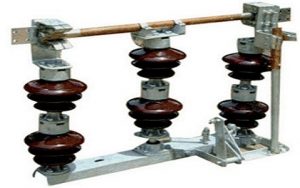The isolator can be defined as; it is one type of mechanical switch used to isolate a fraction of the electrical circuit when it is required. Isolator switches are used for opening an electrical circuit in the no-load condition. It is not proposed to be opened while current flows through the line. Generally, these are employed on circuit breaker both the ends thus the circuit breaker repair can be done easily without any risk.
Rich power offers good quality break isolators and switch breakers and separable connectors. OEM production is accepted.We also offer spare parts of switchgear and disconnector.
Advantage:
- Improved swing arm stability for the higher voltage switches over 300 kV. Since the switchblade pivots in the center and breaks at both ends, the horizontal rotation is inherently more stable with regard to mechanical vibration.
- Improved switching in high winds since the blade is connected to the center, the wind force acting on each exposed blade counterbalances the opposite end and effectively reduces the rotating torque caused by the wind acting on the blade.
- Improved switching with heavy ice loading since the rotation is in a horizontal plane, lifting heavy ice is eliminated along with ice sliding down an inclined blade and possibly jamming a pivot mechanism.
- Phase spacing is not an issue since the blade is not energized as it swings to the end of travel in the open position.
- Arc interruption is faster since the arc length increases at a faster rate per degree of rotation than a single-end break switch.
- Lower corona when open due to streamlined design and not having a pointed switchblade that remains energized after opening.
- Low profile design when open compared to a vertical break design.
- The only disadvantage is slightly higher contact resistance since there are two sets of contacts instead of one. The blade shaft does rotate after entering the jaws and this motion wipes away oxide film resulting in minimal contact resistance.
Differences:
An isolator is a switch, used to disconnect an electrical circuit for safety or maintenence.
The various poles are independent electrical switches, isolated from each other electrically, but mechanically coupled so as to be operated by a single toggle or lever. The lever can usually be padlocked open, or have some locking device clamped onto it, for safety.
For a single-phase circuit:
there are two types of isolators:
- Single pole – a switch, typically in the live leg
- Double pole – a pair of mechanically coupled switches,, one in the live leg and one in the neutral
- The double pole version is usually preferred, as it allows complete separation of the circuit being worked on. You can’t, for example, perform an insulation-to-ground test with single-pole isolation, as the neutral leg is still connected and neutral is earthed at the source.
For a three-phase supply:
there are two analogous types
- Three pole – three interlocked switches in the three live legs
- Four pole – as three, but with one in the neutral as well.
- Again, the four poles are preferred, for the same reason.
So, the difference between a single pole and three poles apart from the self-evident number of poles, is that one is intended for use with single-phase circuits, and the other with three-phase circuits.
[1] note that an isolator is not an overload protection device. It will not open automatically to protect against faults. For that, you need a fuse, a thermal trip, or an MCB.
[2] MCBs can often be used as an isolator, if they can be locked off.
[3] many isolators are off-load switches they are not designed to us connect the full load current. The machine must be stopped elsewhere first.
[4] note that in North America households have a weird dual-phase setup, where 120V sockets have live and neutral, and 240V sockets have two (different) live wires, and (sometimes) a neutral. Those 240V sockets require a double-pole isolator as a minimum, and a triple-pole to isolate the neutral too.

